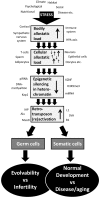Stress-induced transposon reactivation: a mediator or an estimator of allostatic load?
- PMID: 29492295
- PMCID: PMC5804529
- DOI: 10.1093/eep/dvw015
Stress-induced transposon reactivation: a mediator or an estimator of allostatic load?
Abstract
Transposons are playing an important role in the evolution of eukaryotic genomes. These endogenous virus-like elements often amplify within their host genomes in a species specific manner. Today we have limited understanding when and how these amplification events happens. What we do know is that cells have evolved multiple line of defenses to keep these potentially invasive elements under control, often involving epigenetic mechanisms such as DNA-methylation and histone modifications. Emerging evidence shows a strong link between transposon activity and human aging and diseases, as well as a role for transposons in normal brain development. Controlling transposon activity may therefore uphold the fine balance between health and disease. In this article we investigate this balance, and sets it in relation to allostatic load, which conceptualize the link between stress and the "wear and tear" of the organism that leads to aging and disease. We hypothesize that stress-induced retrotransposon reactivation in humans may be used to estimate allostatic load, and may be a possible mechanism in which transposons amplify within species genomes.
Keywords: allostasis; allostatic load; epigenetic silencing; retrotransposons; stress; transposons.
Figures

References
-
- Selye H. Confusion and controversy in the stress field. J Human Stress 1975. ; 1 : 37 – 44 . - PubMed
-
- Sterling P, Eyer J. Allostasis: A new paradigm to explain arousal pathology. 1988. .
-
- McEwen BS, Stellar E. Stress and the individual: mechanisms leading to disease. Arch Intern Med 1993. ; 153 : 2093 – 101 . - PubMed
-
- Korte SM, Koolhaas JM, Wingfield JC. et al. . The Darwinian concept of stress: benefits of allostasis and costs of allostatic load and the trade-offs in health and disease. Neurosci Biobehav Rev 2005. ; 29 : 3 – 38 . - PubMed
Publication types
LinkOut - more resources
Full Text Sources
Other Literature Sources

